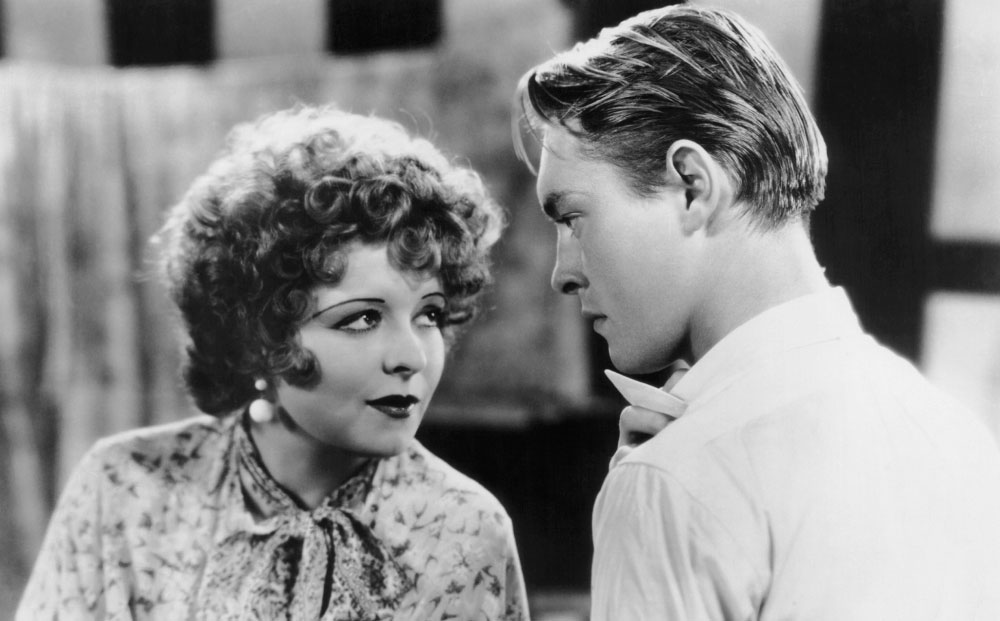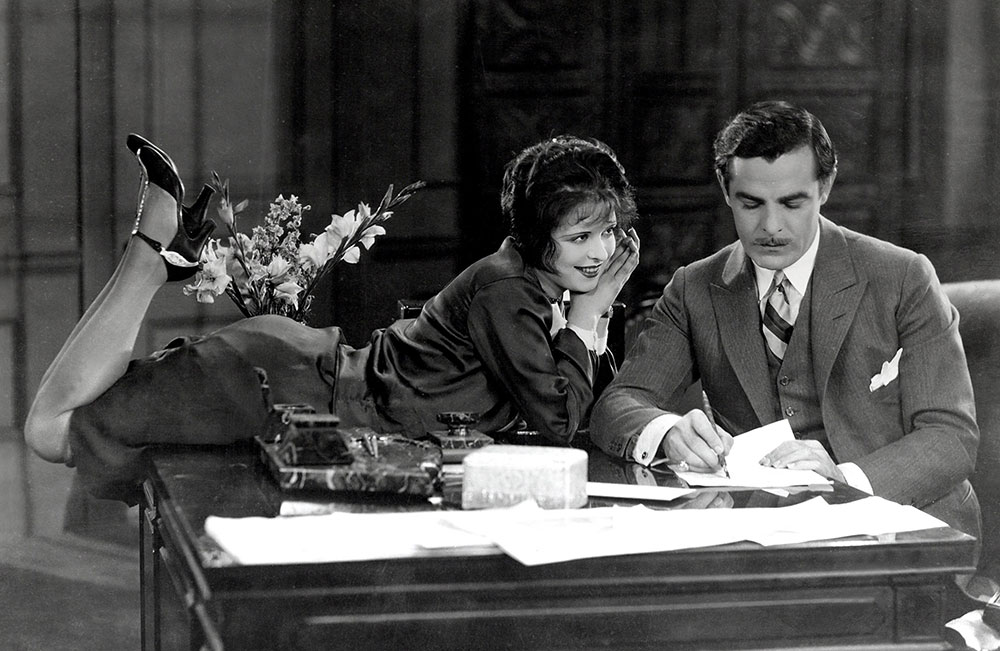Since October, Film Forum has dedicated its Monday nights to the original It-girl, Clara Bow. Bow captured the flapper zeitgeist in film, and with her short dresses, wild red hair, and penchant for playing working women who partied hard and loved harder, she brought a modern, more liberated womanhood to the masses. Despite having worked in Hollywood for only one decade, Bow had a prolific output, and her legacy reverberates in popular culture to this day, most recently as the inspiration for Margot Robbie’s character in Babylon (2022) and the title of a Taylor Swift song. She flourished during a major turning point in American film history, being one of few actors to successfully transition from silent films to talkies with their stardom—and a very strong Brooklyn accent—intact.
However, that stardom burned bright and quick. At age 20, Bow appeared in 15 films in a single year; by 28, she was retired. The story of her rise-and-fall often eclipses appreciation of her talent, since she’s often pointed to as either a cautionary tale, or as an example of how the Hollywood machine has, and continues to, elevate young women just to knock them down. Film Forum’s retrospective highlights the breadth of Bow’s work, from her more well-known romantic comedies to her more dramatic roles, including the aerial action movie Wings (1927), the first film to win an Academy Award for Best Picture. An exciting standout is The Pill Pounder, a previously-lost 1923 silent short that was inadvertently rediscovered at a car park auction in Omaha, Nebraska, and restored just last year, a century after the film’s original release.
Bow had a very difficult childhood, growing up in poverty in Prospect Heights, Brooklyn, with an abusive father and a mother who suffered from seizures and violent psychotic episodes. She sought refuge in going to the movies and was determined to become an actress. A nationwide Fame and Fortune magazine acting contest in 1921 was her supposed ticket out. Despite her win, Bow still had to hustle, visiting the magazine publisher repeatedly until they found a Hollywood role for her. But this grit paid off and she eventually got a small part as a flapper in Beyond the Rainbow (1922). Bow would appear in 36 films over the next 5 years, her star quickly rising and snowballing into a contract with Paramount Pictures, before It (1927, pictured at top), the film that cemented her status as a box office draw and as the quintessential flapper, was released
The popular British romance writer Elinor Glyn popularized the concept of the “It”—the type of magnetism that makes certain people irresistible, or what we may now refer to as “star power,” “the x-factor,” or as kids these days say, “rizz”—with her screenplay for the film of the same name. Paramount (and Glyn herself, who has a cameo in the film) declared that the person who epitomized this mysterious quality was none other than Bow, and upon watching the film, it’s hard to argue with that claim. As the working-class shopgirl Betty Lou Spence, Bow exhibits a certain facial expressiveness and set of lively mannerisms that lead her boss, Cyrus Waltham Jr. (Antonio Moreno), owner of the “world’s largest store,” to fall in love with her. She shows Cyrus a side of New York that he’s never seen in his upper crust circles by whisking him to Coney Island on a date. He can’t help but be charmed by her. Although they come from very different backgrounds and Cyrus has a wealthy socialite as a romantic option, he can’t resist Betty because she just has It.
Bow’s character in It also represents her public persona. One can almost see It as the Hollywood version of her actual life, where a working-class girl who innately possesses an inexplicable quality is able to both rise above her circumstances and transcend her background, while still maintaining the spark that makes her who she is. She has tremendous sex appeal, but isn’t inaccessible to female fans who strive to see themselves in her. A scene in It that conveys this features Betty getting ready for a date with Cyrus. She puts on a conservative collared dress with long sleeves and doesn’t like the look, so she takes a pair of scissors to it, transforming it into a fashionable flapper frock with thin straps and a plunging neckline. The regular girl in a cramped New York City apartment may not have the means to buy the best gowns, but with her ingenuity she can shape the world and her image to her liking.

The characters Bow played were often wild women, whose blithe attitudes toward decorum and gender norms endeared men (and audiences) to her, but also had to be tamed in order to receive a happy ending. The drama in many of the romantic comedies she leads centers around whether her love interests will be successful in getting her to settle down, or whether they can accept her for who she is. In her first hit film, The Plastic Age (1925), Bow plays a girl who introduces a well-behaved college freshman to partying, drinking, and sex, but breaks up with him when she realizes she’s a bad influence and his grades are suffering. She returns to him only once she’s tamed her wild ways and is ready to settle down. Similarly, in Dorothy Arzner’s The Wild Party (1929, Bow’s first talkie), Bow is a brassy, popular girl at an all-female college who navigates maturing past her carefree partying lifestyle, determined to show the prim and proper professor (Fredric March) she loves that she is ready to be with him. Alternatively, in Mantrap (1926), Bow’s Alverna is a bored housewife in the backwoods of Canada who attempts to run away with a lawyer visiting the area on a camping trip. Her husband tells the lawyer that he can have Alverna, but that she'll never stop flirting. Alverna gets her happy ending, however, when the lawyer marries her anyway, having accepted her flirtatious ways.
The friction Bow’s characters experience between their natural urges and society’s expectations reflects the actress’s own dynamic with Hollywood, a business in which she provided tremendous box office success, but was always socially sidelined from. She spoke candidly in interviews about not feeling accepted among those in the industry—at this point in Hollywood, there was a good deal of class anxiety and concern with proving that the business was not trashy—and stars like Bow who behaved like, well, people, posed a challenge.
In an interview with Photoplay, Bow stated, “They yell at me to be dignified. But what are the dignified people like? The people who are held up as examples to me? They’re snobs. Frightful snobs… I’m a curiosity in Hollywood. I’m a big freak because I’m myself.” While Bow’s sexual allure and libertine attitudes are what fascinated audiences and made her a box office success, they also made her the target of wild speculation and scandal, as she struggled with highly publicized romantic relationships, money trouble, and her own mental health. Her sexuality was frequently written about, with ridiculous rumors published about her; Kenneth Anger famously included a chapter about her in Hollywood Babylon where he claimed she slept with the entire USC football team.
Elements of Bow’s characters dovetailed with her real life persona, often causing controversy both on and off-screen. The form-hugging, transparent dress she wears in My Lady of Whims (1925), a costume that was scandalous even by the standards of the flapper era, attracted a lot of press—and people are still writing about it. Call Her Savage (1932) features a scene in which she visits a bar with same-sex couples and cross-dressing waiters. This was toward the end of the “Pansy Craze” in which queer performers, and drag queens, had increased visibility in film and culture. A scene like this would be impossible only a couple years later when the Hays Code was implemented. Like the real life Bow, her characters never understood the uproar, instead wondering what the big deal was when others reacted with such shock at her behavior or outfits.
Tonight, the series concludes with a 35mm print of Hoopla (1933, pictured at top), Bow’s final film, and a thematically fitting end to her career. Bow plays Lou, a cooch dancer who is offered $100 to seduce the naïve, sheltered son (Richard Cromwell) of a carny named Nifty Miller (Preston Foster). Nifty wants his son Chris to return to school and not get sucked into the traveling circus lifestyle from which he’s been shielded, but Chris is, of course, enchanted by Lou’s free-spiritedness, which is exemplified by her skinny-dipping in front of him with no sense of shame. The two fall in love and secretly marry, despite Lou’s insecurity that she’s not good enough for Chris. They leave for Chicago after Nifty angrily kicks them out. Nifty later learns that, although times are tough, Lou and Chris are getting by in Chicago, with Lou dancing at the World’s Fair and Chris working in a law office. Unlike other films in which Bow’s character resolves to sand down her rough edges, Hoopla ends with Chris defending Lou to his disapproving father, praising her for financially supporting him with her dancing and giving him the opportunity to study law. In Bow’s swan song performance, her character gets an imperfect happy ending—she’s loved for who she is and valued for how she lives.
Bow had already retreated from show business by the time she filmed Hoopla, which was the second of a short two-picture deal with Fox, essentially one last go-around after major burnout and a stay in a sanatorium. She struggled with mental health for the rest of her life, which was spent in privacy on her husband’s cattle ranch in Nevada. Despite how iconic she once was, she faded significantly from Hollywood memory compared to other stars of the same era—especially unfortunate considering it’s an industry that perpetually memorializes itself. Speaking to Adela Rogers St. John at age 22, Bow said, “I don’t think I’m very different from any other girl— except that I work harder and have suffered more. And I have red hair.” She may not have been different from other girls, but she was very different from other celebrities. The dark underbelly of Old Hollywood and the dirty secrets of its carefully-crafted stars are endlessly fascinating, but Bow never did much hiding. She lived and loved openly, flourished and faltered publicly, and at the end of the day, was just a kid from Brooklyn, not Babylon.
Hoopla screens this evening, December 30, at Film Forum on 35mm as part of the series “Clara Bow.” David Stenn, author of Clara Bow: Runnin’ Wild, will be in attendance for a book signing after the screening.



